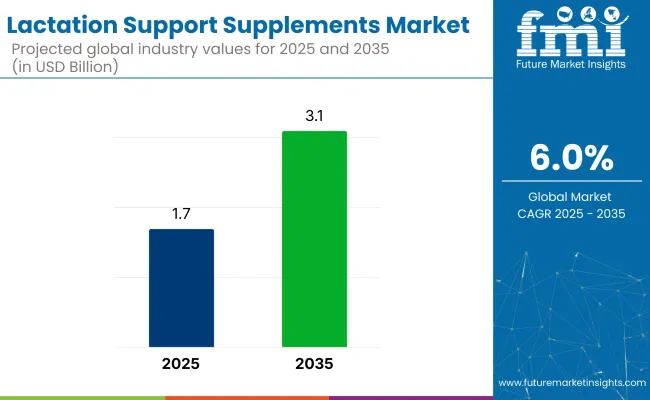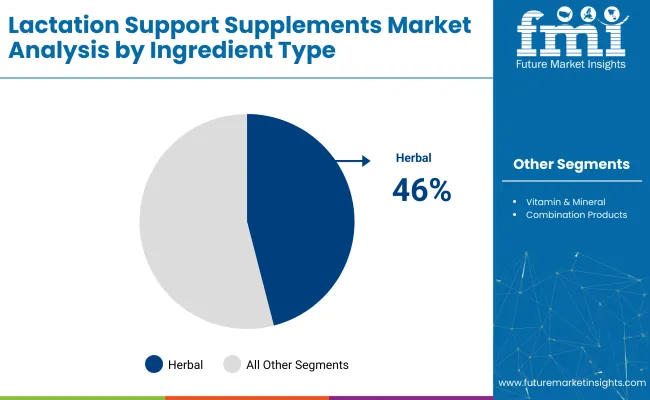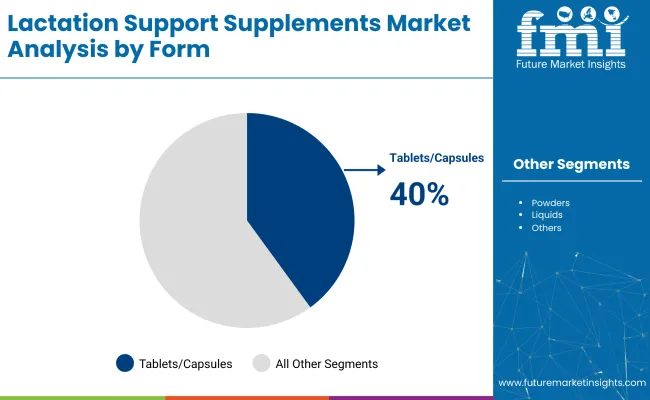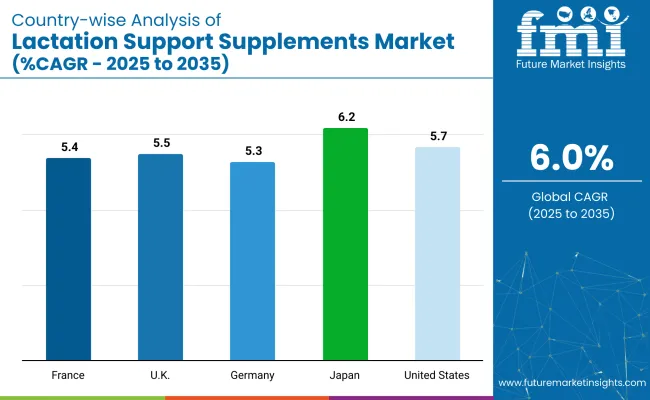The global lactation support supplements market is valued at USD 1.7 billion in 2025 and is slated to reach USD 3.1 billion by 2035, reflecting a CAGR of 6.0%.

| Metric | Value |
|---|---|
| 2025 Market Size | USD 1. 7 billion |
| 2035 Market Size | USD 3. 1 billion |
| CAGR (2025 to 2035) | 6.0% |
This growth is expected to be driven by increasing awareness of maternal health, rising breastfeeding promotion campaigns, and innovations in herbal lactation formulations. Additionally, demand will be supported by online pharmacy expansion, customized supplement programs, and integration of traditional herbs with modern supplement delivery formats.
Japan is projected to register a CAGR of 6.2%, driven by high per capita maternal health spending and a preference for traditional herbal formulations. The UK is expected to grow at a CAGR of 5.5% due to rising maternal health awareness and demand for organic supplements.
Germany will record a CAGR of 5.3%, supported by strong healthcare spending and preference for scientifically validated herbal products. Herbal supplements will dominate the ingredients segment with a 46% market share, while tablets/capsules will lead the form segment with a 40% share in 2025.
The lactation support supplements market holds a small but significant share within its parent markets. It accounts for approximately 4-5% of the overall food supplement and nutrition market, given its specialised focus on maternal health.
Within the maternal health supplements segment, it captures a larger share of around 15-20%, driven by the high demand for breastfeeding support. In the broader dietary supplements market, its share remains below 2%, as it serves a niche audience. However, its contribution to the healthcare and wellness market is growing steadily due to rising awareness and innovation in lactation-specific products worldwide.
The lactation support supplements market is segmented by ingredient type, form, distribution channel, and region. By ingredient type, the market is segmented into herbal supplements, vitamin & mineral supplements, and combination products. By form, it is classified into tablets/capsules, powders, liquids, gummies, and others, which include sprays, lozenges, chewable strips, effervescent tablets, amino acid-based supplements, and probiotic blends.
By distribution channel, it is divided into retail pharmacies, supermarkets/hypermarkets, specialty stores, online pharmacies, brand websites, and others, comprising direct sales via lactation consultants, hospital pharmacies, community health program distributions, multi-level marketing channels, and local co-operative outlets. By region, the market is analyzed across North America, Latin America, Western Europe, Eastern Europe, Balkans & Baltic, Russia & Belarus, Central Asia, East Asia, South Asia & Pacific, and Middle East & Africa.
Herbal supplements are projected to remain the most lucrative segment, accounting for 46% of the market share in 2025.

Tablets/capsules are expected to be the most lucrative segment, holding around 40% of the market share by 2035.

Online pharmacies are projected to be the most lucrative segment, holding approximately 28% of the market share by 2035.
The global lactation support supplements market is growing steadily, driven by increasing awareness of maternal health, rising demand for natural lactation-enhancing supplements, and innovations in herbal formulations with convenient delivery formats.
Recent Trends in the Lactation Support Supplements Market
Challenges in theLactation Support Supplements Market

Among the top countries, Japan is projected to record the highest growth rate with a CAGR of 6.2%, driven by high maternal health spending and preference for traditional herbal supplements. The USA follows with a CAGR of 5.7%, supported by its mature supplements industry and strong research capabilities.
The UK is expected to grow at 5.5%, aided by government initiatives and demand for organic products, while France will record a CAGR of 5.4%, driven by consumer preference for natural supplements. Germany has the slowest growth among these countries at 5.3%, despite strong healthcare spending and product validation.
The report covers an in-depth analysis of 40+ countries; five top-performing OECD countries are highlighted below.
The USA lactation support supplements market is projected to grow at a CAGR of 5.7% during the forecast period.
Sales of lactation support supplements in the UK are expected to register a CAGR of 5.5% during the forecast period.
Sales of lactation support supplementsin Germany are anticipated to grow at a CAGR of 5.3% during the forecast period.
France's lactation support supplements revenue is projected to grow at a CAGR of 5.4% during 2025-2035.
The lactation support supplements revenue in Japan is forecasted to expand at a CAGR of 6.2% during the forecast period.
The market is moderately fragmented, with competition among tier-one companies such as Fairhaven Health, UpSpring, Motherlove, Majka, and Legendairy Milk, alongside many regional and niche brands. Top companies compete through pricing strategies, product innovation, clean-label certifications, partnerships, and international expansion initiatives to strengthen their market position.
Companies such as Fairhaven Health and UpSpring focus on innovative formulations combining traditional herbs with modern delivery formats like powders, capsules, and probiotic blends. Strategies adopted include expansion of online sales channels, development of personalised lactation programs, and acquisitions to broaden product portfolios.
Recent Lactation Support Supplements Industry News
| Report Attributes | Details |
| Current Total Market Size (2025) | USD 1.7 billion |
| Projected Market Size (2035) | USD 3.1 billion |
| CAGR (2025 to 2035) | 6.0% |
| Base Year for Estimation | 2024 |
| Historical Period | 2020 to 2024 |
| Projections Period | 2024 to 2035 |
| Market Analysis Parameters | Revenue in USD billions/Volume in Metric Tons |
| By Ingredient Type | Herbal Supplements, Vitamin & Mineral Supplements, and Combination Products |
| By Form | Tablets/Capsules, Powders, Liquids, Gummies, Others (Sprays, Lozenges, Chewable Strips, Effervescent Tablets) |
| By Distribution Channel | Retail Pharmacies, Supermarkets/Hypermarkets, Specialty Stores, Online Pharmacies, Brand Websites, Others (Direct Sales Through Lactation Consultants, Hospital Pharmacies, Community Health Program Distributions, and Multi-Level Marketing Channels) |
| Regions Covered | North America, Latin America, Western Europe, Eastern Europe, East Asia, South Asia & Pacific, Middle East & Africa |
| Countries Covered | United States, Canada, United Kingdom, Germany, France, China, Japan, South Korea, Brazil, Australia |
| Key Players | Fairhaven Health, UpSpring, Motherlove, Majka, Legendairy Milk, Pink Stork, Happy Family Organics, Naturelo, Earth Mama, Wellements, Metagenics, Nature's Way, Solgar, Freemie, and Milkful |
| Additional Attributes | Dollar sales by value, market share analysis by region, and country-wise analysis |
As per Ingredient Type, the industry has been categorized into Herbal Supplements, Vitamin & Mineral Supplements and Combination Products.
As per Form, the industry has been categorized into Tablets / Capsules, Powders, Liquids, Gummies and Others.
As per Distribution Channel, the industry has been categorized into Retail Pharmacies, Supermarkets / Hypermarkets, Specialty Stores, Online Pharmacies, Brand Websites and Others.
Industry analysis has been carried out in key countries of North America, Latin America, Western Europe Eastern Europe, Balkans & Baltic, Russia & Belarus, Central Asia, East Asia, South Asia & Pacific and Middle East & Africa.
The global market is valued at USD 1.7 billion in 2025.
The market is forecasted to reach USD 3.1 billion by 2035.
Herbal supplements lead with a 46% market share in 2025.
The market is expected to grow at a CAGR of 6.0% during the forecast period.
Japan is projected to register the highest CAGR of 6.2% from 2025 to 2035.






Full Research Suite comprises of:
Market outlook & trends analysis
Interviews & case studies
Strategic recommendations
Vendor profiles & capabilities analysis
5-year forecasts
8 regions and 60+ country-level data splits
Market segment data splits
12 months of continuous data updates
DELIVERED AS:
PDF EXCEL ONLINE
Unsupported Single Coated Tape Market Size and Share Forecast Outlook 2025 to 2035
Life Support Systems Market Size and Share Forecast Outlook 2025 to 2035
Soft Support Products Market
Organ Support Supplements Market Analysis Size and Share Forecast Outlook 2025 to 2035
Memory Support Supplement Market Size and Share Forecast Outlook 2025 to 2035
Combat Support Vehicle Market
Cancer Supportive Care Products Market Trends – Growth & Forecast 2020-2030
Die Cut Support Pads Market Size and Share Forecast Outlook 2025 to 2035
Enclosure Support Arm Systems Market Size and Share Forecast Outlook 2025 to 2035
Aircraft Ground Support Equipment Market Size and Share Forecast Outlook 2025 to 2035
Clinical Trials Support Software Solutions Market Size and Share Forecast Outlook 2025 to 2035
Clinical Decision Support Systems Market Size and Share Forecast Outlook 2025 to 2035
GLP-1 Nutritional Support Market Analysis - Size, Share, and Forecast Outlook 2025 to 2035
Clinical Decision Support App Market – AI-Powered Insights 2034
Orthopedic Braces and Support Market Forecast and Outlook 2025 to 2035
Korea Aircraft Ground Support Equipment Market – Trends & Forecast 2025-2035
Japan Aircraft Ground Support Equipment Market Analysis & Forecast by Equipment, Ownership, Power, Application, and Region Through 2025 to 2035
Military and Defense Ground Support Equipment Market Size and Share Forecast Outlook 2025 to 2035
Western Europe Aircraft Ground Support Equipment Market Analysis by Equipment, Power, Ownership, Application and Region: Forecast for 2025 to 2035
Veno-Venous Extracorporeal Life Support (VV ECLS) Devices Market Size and Share Forecast Outlook 2025 to 2035

Thank you!
You will receive an email from our Business Development Manager. Please be sure to check your SPAM/JUNK folder too.
Chat With
MaRIA